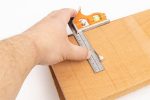The Tape Measure: A Woodworker’s Trusty Companion
Tape measure is a flexible measuring tool used by craftsmen to accurately measure the dimensions of wood pieces and other materials.
Typically made of a flexible metal strip, a tape measure is housed within a compact case.
The metal strip is marked with precise measurements in both imperial (inches and feet) and metric (centimeters and meters) units.
Woodworkers use tape measures to determine the length, width, and height of wood pieces, as well as to measure clearances, layouts, and distances accurately.
This tool is essential for ensuring precise cuts, joints, and assemblies in woodworking projects, contributing to the overall accuracy and quality of the finished piece.
The Anatomy of a Tape Measure
The tape measure is a seemingly simple yet highly effective tool, with a detailed anatomy that ensures its accuracy and usability.
Here’s a comprehensive breakdown of its components:
1.) Tape
The tape, made of a durable material such as steel, fiberglass, or nylon, is the flexible strip that extends and retracts from the case.
It is marked with measurement increments in both imperial and metric units.
The tape’s material provides it with strength and flexibility, allowing it to withstand bending and extending without breaking.
2.) Case
The case is usually made of plastic or metal and serves as a protective housing for the tape. It houses the coiled tape when it is retracted, keeping it safe from damage.
The case often features a belt clip or lanyard hole for easy portability, allowing woodworkers to carry it conveniently on their belts or tool belts.
3.) Hook or Endpiece
The hook, also known as the endpiece, is located at the end of the tape. It is designed to move slightly to accommodate both internal and external measurements accurately.
The hook has a slight indentation, ensuring accurate measurements whether the tape is hooked onto the edge of a piece or butted against it.
4.) Locking Mechanism
The locking mechanism, operated by a button or lever on the case, allows woodworkers to secure the tape at a specific length.
When engaged, it prevents the tape from retracting, ensuring consistent measurements without the need for an extra hand to hold the tape in place.
5.) Blade
The blade is the flat, metal strip that extends from the case when the tape measure is in use.
It contains the measurement markings and is usually coated for durability, enhancing readability and protecting the markings from wear and tear.
6.) Thumb Brake
Some tape measures have a thumb brake near the case, allowing the user to control the retraction speed of the tape by applying gentle pressure while retracting it.
This feature enhances user control, preventing the tape from snapping back too quickly, which could potentially cause injury or damage.
7.) Measurement Markings
The measurement markings are precisely printed or etched onto the tape’s surface.
These markings are in both imperial units (inches and feet) and metric units (centimeters and meters), allowing woodworkers to take accurate measurements regardless of the unit system they prefer to use.
8.) Blade Coating
Many modern tape measures have a protective coating on the blade, which can be made of materials like nylon or Mylar.
This coating enhances the durability of the measurement markings, making them resistant to abrasion and fading over time.
Understanding the intricacies of a tape measure’s anatomy is essential for woodworkers, enabling them to make precise measurements and achieve accurate results in their woodworking projects.
Types of Tape Measures
1.) Standard Tape Measures
These are the most common type, suitable for general woodworking tasks. They come in various lengths, ranging from a few feet to several meters, catering to different project requirements.
2.) Long Tape Measures
Designed for measuring longer distances, these tapes can extend for tens of meters, making them ideal for large-scale woodworking projects and layout work.
3.) Pocket Tape Measures
Compact and portable, pocket tape measures easily fit into a woodworker’s pocket, providing quick measurements on the go.
4.) Digital Tape Measures
Modern advancements have introduced digital tape measures that display measurements on an LCD screen. They offer precise readings and may include additional features such as built-in spirit levels and memory functions.
5.) Versatility in Woodworking
The tape measure’s versatility in woodworking projects is unparalleled. Here’s how it proves its worth in various tasks:
6.) Accurate Measurements
Woodworkers rely on precise measurements to ensure components fit together seamlessly. Whether it’s determining the length of a board or the dimensions of a joint, the tape measure provides accurate readings.
7.) Layout and Marking
Before making cuts or assembling pieces, woodworkers use tape measures to mark the material accurately. Layout lines guide the cutting process, ensuring accuracy and minimizing waste.
8.) Checking Squareness
Woodworkers often use the tape measure in conjunction with the Pythagorean theorem to check if a project is square. By measuring diagonally across a square or rectangular assembly, they can confirm its true angles.
9.) Estimation and Planning
Tape measures aid in estimating materials needed for a project. Woodworkers can calculate the required lengths of wood, helping them plan their purchases and minimize wastage.
Mastering the Art of Tape Measure Usage
To harness the full potential of a tape measure, craftsmen adhere to essential guidelines:
1.) Proper Technique
Holding the tape measure taut and straight ensures accurate measurements. Avoiding bends or kinks in the tape is crucial for precise readings.
2.) Reading Measurements
Understanding the markings on the tape measure, including fractions and decimals, is fundamental. Woodworkers interpret measurements based on project requirements, ensuring accuracy in their cuts and joints.
3.) One-Person Measurements
For solo woodworking projects, craftsmen often employ clever techniques, such as using a piece of wood or a clamp to hold one end of the tape measure, enabling them to take accurate measurements without assistance.
4.) Maintenance
Regularly checking the tape for signs of wear, ensuring the locking mechanism functions correctly, and keeping the tape clean contribute to its longevity and accuracy.
Conclusion
In the intricate dance of woodworking, where precision is paramount, the tape measure emerges as a silent yet essential partner.
Its ability to provide accurate measurements, facilitate intricate layouts, and aid in meticulous planning ensures that woodworking projects come together flawlessly.
As woodworkers continue to craft timeless pieces, the tape measure remains an enduring symbol of accuracy and craftsmanship, proving that even in the digital age, traditional tools remain irreplaceable.
So, the next time you marvel at a perfectly crafted piece of woodwork, remember the humble tape measure that played a silent yet indispensable role in its creation.

Don Kerr spent many years honing his skills as a DIY woodworker. He finds immense joy in not only creating remarkable pieces but also in generously sharing his knowledge. Connect with him via group.



